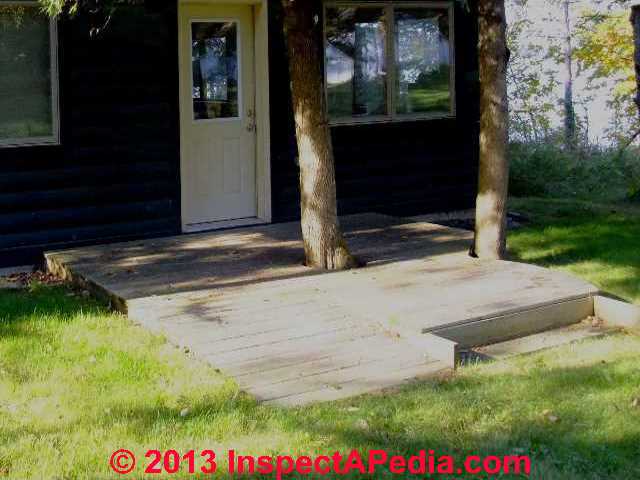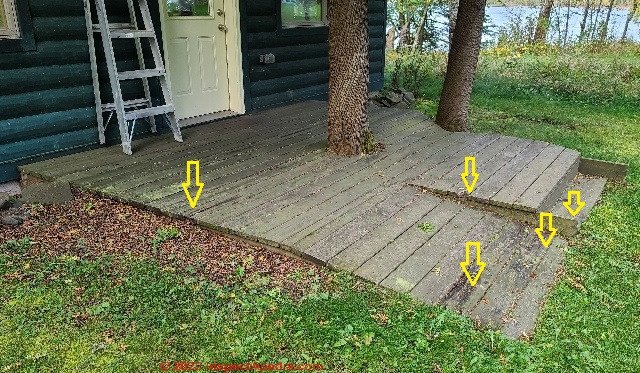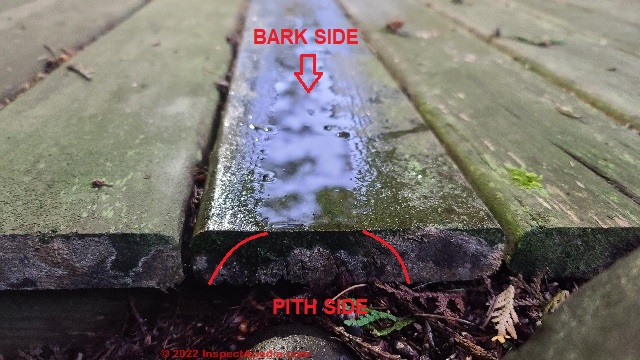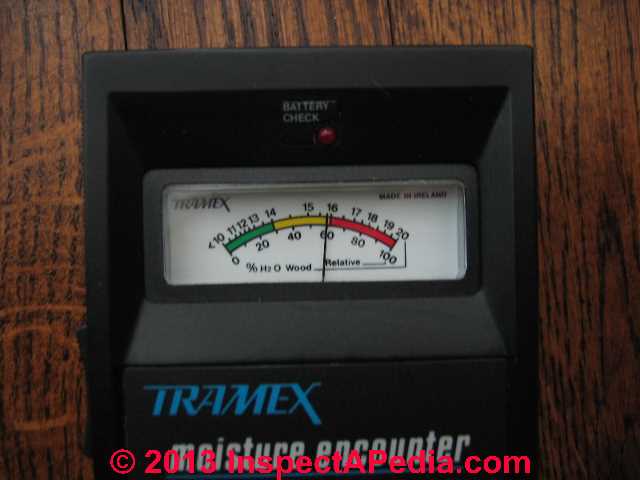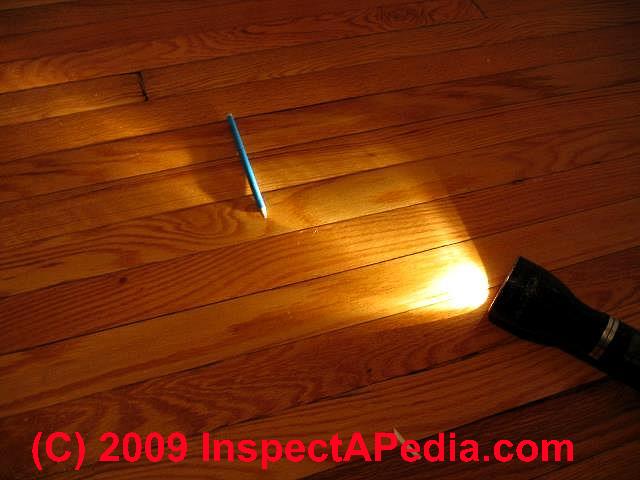 Wood Board Cupping, Moisture Effects
Wood Board Cupping, Moisture Effects
- POST a QUESTION or COMMENT about wood deck & porch construction: board cupping cause and prevention
Wood board cupping caused by moisture differences, wet basements, crawl space moisture, or indoor flooding: here we explain how to look at which way a board has cupped to determine where moisture is or has come from.
This article series explains the causes of cupping in wood boards & wood board right side up advice for steps, decks, ramps, concluding which side of boards should face up or down (bark side down or bark side up in some cases) when building a deck or exterior wood stairs.
InspectAPedia tolerates no conflicts of interest. We have no relationship with advertisers, products, or services discussed at this website.
- Daniel Friedman, Publisher/Editor/Author - See WHO ARE WE?
Wood Cupping In Response to Which Side of Board is More Wet
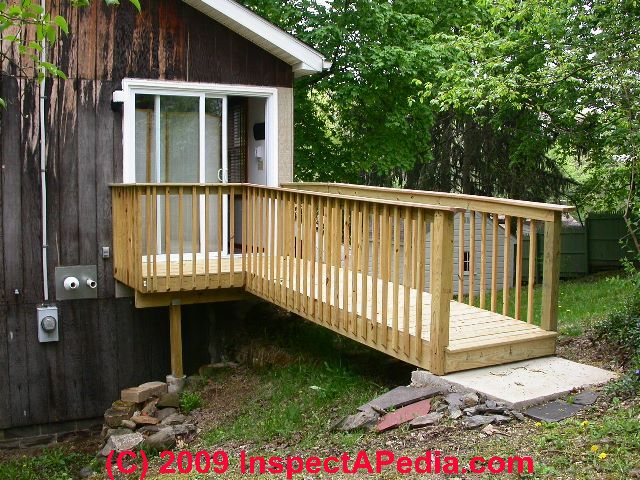
For decks constructed high enough to allow air circulation below the deck flooring, the moisture level of the bottom of the deck or step boards is less changeable than the deck's upper surface.
While both sides may become quite wet in rainy or melting-snow conditions, the upper side of the deck or stairs in many locations gets direct sunlight more variations in moisture level than its under-side.
In the ramp and entry platform shown above and that we built at an older home in Poughkeepsie, New York, there is no sun exposure on the under-side of this wood ramp but nonetheless the underside of the entry deck and ramp are exposed to air, drying, and perhaps more stable moisture levels than the upper surface that is further exposed to rain and snow.
In contrast, in the case of the ground-level deck shown below, the under-side of the deck boards may remain more wet than the upper-side, thus reversing the level of moisture exposure and risking that the deck boards will cup in the concave pattern on the walking surface- DF.
The ground level entry deck shown above, at a green lot cabin built in Two Harbors, MN, in 2006, using treated wood for both framing and the deck boards is shown in-use in 2013. Below we see details of the condition of this deck in 2022, sixteen years after its original construction.
The lack of ventilation under this deck is a factor in the rot developing on several of its boards (yellow arrows)..
More about the life & hazards of this entry deck is
FPL experts agree that on an exterior wood deck, ramp or stair the under-side of wood boards tends to vary less in moisture level than the upper or exposed side. In addition to cupping problems the exposed deck side is more prone to checking and of course photo oxidation wear. - DF
Below we show another board in this same entry deck, one with notable cupping that holds water, inviting greater algae growth and possibly rot.
So I [SB] stand corrected and will install future decking bark side up – ... or down ... according to the wood experts, or more likely avoid the issue altogether and use bark-less composite materials.- Steve Bliss
See DECK BOARD COMPOSITE PRODUCTS
Steve Bliss's Building Advisor at buildingadvisor.com helps homeowners & contractors plan & complete successful building & remodeling projects: buying land, site work, building design, materials & components, & project management through complete construction.
Interior Wood Floor Cupping In Response to Which Side of Board is More Wet
When one side of a board contains more moisture than the other, the wetter side tends to expand and "arch" forming a convex shape while the opposite side of the board, the more dry side, tends to form the under-side of the arch or the concave shape.
Convex-Cupped Interior Wood Floors
 In our photo at above left we are using a non-invasive electronic signal type Tramex moisture meter to check the moisture level in an interior wood floor.
In our photo at above left we are using a non-invasive electronic signal type Tramex moisture meter to check the moisture level in an interior wood floor.
At 18% the moisture is a bit high in this region;
It would be useful to also check conditions below this floor. At above right you can see convex-cupped finish wood flooring by shining a flashlight along the floor surface.
Similarly, in our page top photograph of cupped wood flooring the boards are arcing upwards at the board center and down at the board edges:
we think that there is more humidity in this room-side of the floor in all of these convex-cupped flooring photos, or that the boards may have been exposed to flooding or a very wet floor upper surface.
Our photo provides a close-up image of significant convex wood floor cupping following upper surface soaking of the floor.
Since documentation of this condition was required we used a combination of light and a straight-edged object (a pencil) whose shadow pattern makes clear the degree of convex cupping of the wood flooring.
Concave-Cupped Interior Wood Floors
Conversely, when we see a wood floor installed over a wet or damp basement or crawl space, we may see the opposite pattern: the boards will be cupped with their concave side facing upwards towards the room.
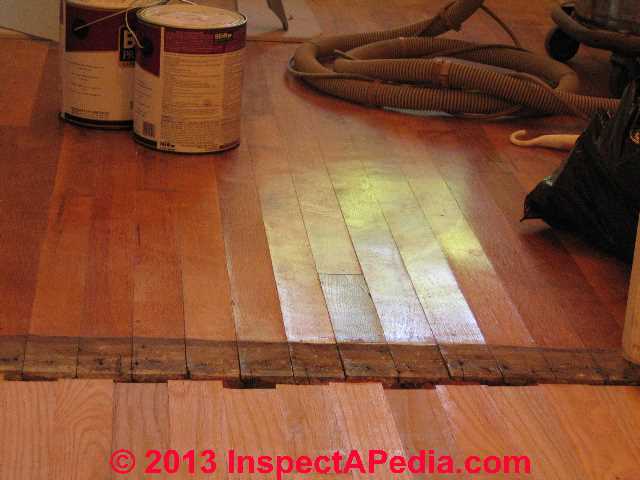 This situation is illustrated in our photo at left. There are two common reasons we find concave cupped wood flooring indoors:
This situation is illustrated in our photo at left. There are two common reasons we find concave cupped wood flooring indoors:
The the wood floor is constructed over a wet basement or crawl space
The wood floor was exposed to flooding that trapped water remained for some time between the finish floor and the subfloor below.
These conditions can cause extreme wood floor damage, even to the extent that the floor expands and explodes upwards as we demonstrate
at WOOD FLOOR DAMAGE
and
The US FPL document discussed at BARK SIDE UP ARGUMENT continues with explanation of other reasons for placing wood with bark side up and pith side (tree center side) down, of which the second notes variations in moisture content across deck boards:
...
The
bottom [under-side] of the deck is not prone to
checking because its moisture content is less changeable than
that of the surface.
...
Continue reading at ANSWER to BARK SIDE UP or DOWN or select a topic from the closely-related articles below, or see the complete ARTICLE INDEX.
Or see these
Reommended Articles
- BARK SIDE UP or DOWN on DECKS & STEPS?
- BUTT JOINT CURLING in FIBER CEMENT SIDING
- DECK & PORCH CONSTRUCTION - home
- FLOOR DAMAGE DIAGNOSIS
- SLIPPERY STAIRS, WALKS, ROOFS
- WOOD FLOOR DAMAGE
- WOOD FLOOR MOISTURE
Suggested citation for this web page
WOOD CUPPING vs WET SIDE at InspectApedia.com - online encyclopedia of building & environmental inspection, testing, diagnosis, repair, & problem prevention advice.
Or see this
INDEX to RELATED ARTICLES: ARTICLE INDEX to BUILDING DECKS & PORCHES
Or use the SEARCH BOX found below to Ask a Question or Search InspectApedia
Or see
INDEX to RELATED ARTICLES: ARTICLE INDEX to BUILDING STRUCTURES
Or use the SEARCH BOX found below to Ask a Question or Search InspectApedia
Ask a Question or Search InspectApedia
Try the search box just below, or if you prefer, post a question or comment in the Comments box below and we will respond promptly.
Search the InspectApedia website
Note: appearance of your Comment below may be delayed: if your comment contains an image, photograph, web link, or text that looks to the software as if it might be a web link, your posting will appear after it has been approved by a moderator. Apologies for the delay.
Only one image can be added per comment but you can post as many comments, and therefore images, as you like.
You will not receive a notification when a response to your question has been posted.
Please bookmark this page to make it easy for you to check back for our response.
IF above you see "Comment Form is loading comments..." then COMMENT BOX - countable.ca / bawkbox.com IS NOT WORKING.
In any case you are welcome to send an email directly to us at InspectApedia.com at editor@inspectApedia.com
We'll reply to you directly. Please help us help you by noting, in your email, the URL of the InspectApedia page where you wanted to comment.
Citations & References
In addition to any citations in the article above, a full list is available on request.
- [1] The moisture content in wood varies depending on not only green un-dried lumber versus dried or kiln dried lumber, but also wood species, the ambient environment, and more. Green lumber that has not been soaked by rain or floating down a river may still have moisture at 30% or above; and wet wood that has been soaked may have 2 1/2 times as much moisture as that same wood species when it has been dried or kiln dried. Free water on or in wood dries quickly but bound water within wood cells takes much longer to dry or requires kiln drying or other measures for its removal.
- [2] The fiber saturation point of wood or wood's FSP is defined as the moisture content of that wood when all of the free water has been removed. Picture the clothes in your clothes washer at the end of a spin cycle. The wet clothing has been squeezed until you couldn't get more water out of it - that clothing is at its fiber saturation point. And just as FSP varies among wood species, if you've ever done laundry you've noticed that some fabrics retain less water at the end of the washer's spin cycle than others.
- [3] Glen D. Huey, "Why Wood Warps", Popular Woodworking Magazine, 12 July 2012, retrieved 7/17/2013 original source http://www.popularwoodworking.com/article/why-wood-warps, reprinting from Woodworking Magazine, Summer 2009.
- [4] Terrie Noll, The Joint Book, Popular Woodworking Books, Cincinnati OH, www.popularwoodworking.com Quarto Publishing, , Inc., 2002, ISBN 1-55870-633-x
- [5] R. Bruce Hoadley, Understanding Wood, Taunton Press
- [6] U.S. D.A. Forest Products Laboratory, "The Wood Handbook",
- [7] Cloutier, Alain, and Yves Fortin. "A model of moisture movement in wood based on water potential and the determination of the effective water conductivity." Wood Science and Technology 27, no. 2 (1993): 95-114.
- [8] Clarke, S. H. "The differential shrinkage of wood." Forestry 4, no. 2 (1930): 93-104. .oxfordjournals.org
- [9] Boyd, J. D. "Relationship between fibre morphology and shrinkage of wood." Wood Science and Technology 11, no. 1 (1977): 3-22.
- [10] Gu, H., A. Zink-Sharp, and J. Sell. "Hypothesis on the role of cell wall structure in differential transverse shrinkage of wood." European Journal of Wood and Wood Products 59, no. 6 (2001): 436-442.
- [11] Barkas, W. W. "Wood water relationships, VI. The influence of ray cells on the shrinkage of wood." Transactions of the Faraday Society 37 (1941): 535-547.
Excerpting: " "The shrinkage of wood is not the same in the three directions of the grain. It is greatest in the tangential (7) direction where the shrinkage per unit change in moisture content dr/dm lies for most woods between 0-2 and 0.4. In the radial (p) direction dp/dm is usually about half this value, while in the longitudinal direction ... [shrinkage] is much smaller, amounting to about 1/50th of the tangential."
- [1]Best Practices Guide to Residential Construction, by Steven Bliss. John Wiley & Sons, 2006. ISBN-10: 0471648361, ISBN-13: 978-0471648369, Hardcover: 320 pages, available from Amazon.com and also Wiley.com. See our book review of this publication.
- [2] Decks and Porches, the JLC Guide to, Best Practices for Outdoor Spaces, Steve Bliss (Editor), The Journal of Light Construction, Williston VT, 2010 ISBN 10: 1-928580-42-4, ISBN 13: 978-1-928580-42-3, available from Amazon.com
- Steve Bliss's Building Advisor at buildingadvisor.com helps homeowners & contractors plan & complete successful building & remodeling projects: buying land, site work, building design, cost estimating, materials & components, & project management through complete construction. Email: info@buildingadvisor.com
Steven Bliss served as editorial director and co-publisher of The Journal of Light Construction for 16 years and previously as building techno\ - [38] Sam Williams and Mark Knaebe, "The Bark-Side/Pith-Side Debate", The Finish Line, (A Forest Products Laboratory finishing factsheet), December 1995, U.S. Forest Products Laboratory, retrieved 9/13/12, original source http://www.fpl.fs.fed.us/documnts/finlines/willi95b.pdf [copy on file as Bark_Side_Wood_FPL.pdf] R. Sam Williams and Mark Knaebe are researchers in Wood Surface Chemistry at the USDA Forest Service, Forest Products Laboratory, One Gifford Pinchot Drive, Madison, WI 53705–2398
- [39] Sarah Lyall, "Bark Up or Down? Firewood Splits Norwegians", The New York Times, 20 February 2013, p. A4.
- In addition to citations & references found in this article, see the research citations given at the end of the related articles found at our suggested
CONTINUE READING or RECOMMENDED ARTICLES.
- Carson, Dunlop & Associates Ltd., 120 Carlton Street Suite 407, Toronto ON M5A 4K2. Tel: (416) 964-9415 1-800-268-7070 Email: info@carsondunlop.com. Alan Carson is a past president of ASHI, the American Society of Home Inspectors.
Thanks to Alan Carson and Bob Dunlop, for permission for InspectAPedia to use text excerpts from The HOME REFERENCE BOOK - the Encyclopedia of Homes and to use illustrations from The ILLUSTRATED HOME .
Carson Dunlop Associates provides extensive home inspection education and report writing material. In gratitude we provide links to tsome Carson Dunlop Associates products and services.


